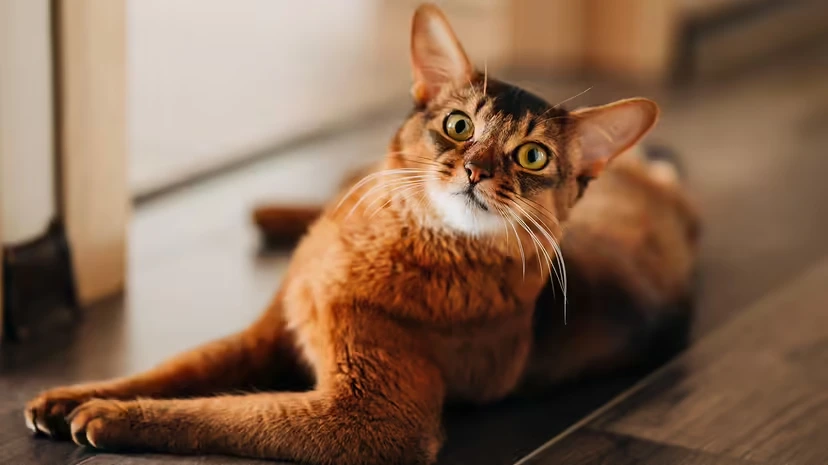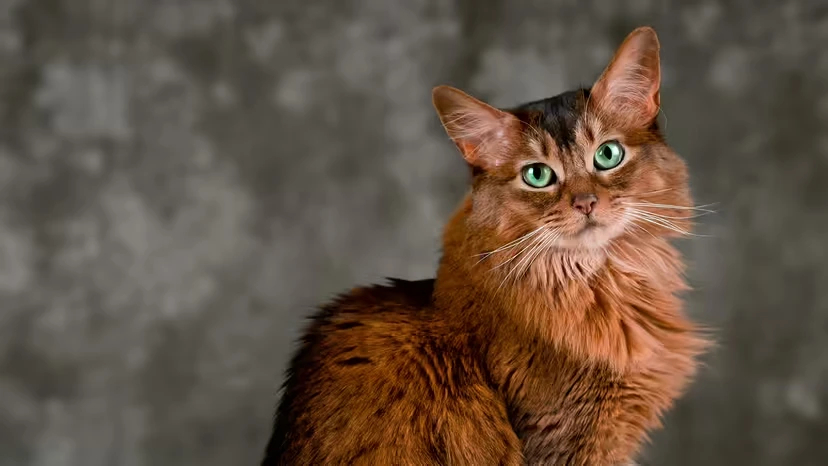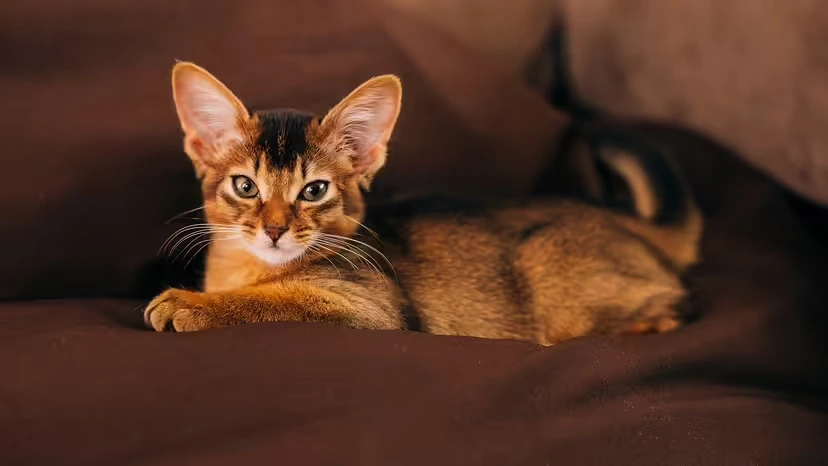TL;DR: The Somali is the long-haired variant of the Abyssinian, famous for its glowing ticked coat, fox-like plumed tail, bright almond eyes, and a playful brain that never clocks out.

Snapshot & Origins
Appearance & Coat Colors
Temperament & Home Life
Enrichment: How to “Drain the Batteries”
Health & Routine Care
Diet & Weight Management
Price Range & How to Choose a Kitten
Best (and Not-So-Best) Homes
Somali vs. Abyssinian: Quick Compare
FAQs
What it is: A long-haired Abyssinian—the look comes from a recessive gene for long hair within Aby lines.
Vibe: Smart, people-oriented, curious, athletic; they “help” with everything and follow you around—but aren’t just lap décor.
Nickname: “Fox cat” (that tail says it all).
Build: Medium, athletic and balanced; light, springy movement.
Head & Face: Soft wedge, large upright ears, almond eyes (gold/amber/green) with a subtle “eyeliner” look.
Coat: Medium to semi-long, silky and fine; each hair shows 3–5 bands of color (the hallmark ticked coat) for that shimmering, sun-kissed effect.
Tail: Full and plumed—the foxy signature.
Common Colors (registries vary slightly):
Ruddy: warm brown base with black/dark ticking.
Blue: cool gray-blue base with steel-blue ticking.
Fawn: pale beige/tan base with creamy ticking.
Sorrel/Cinnamon: coppery red base with cinnamon ticking.
Silver series: near-white roots with contrasting bands for high definition.
Viewing tips: front-light for depth, back-light for shine, side-light for banding.

Social & engaged: Affectionate with their people, polite with visitors after a short warm-up.
High energy: Not a “full-time lap cat”—they crave play, puzzles, and parkour.
Trainability: Excellent. Clicker training, recall, touch targets, fetch—easy wins.
With other pets: Generally good with cats/dogs given slow introductions and smart resource planning.
Environment: Thrive where humans interact daily; boredom is the root of most mischief.
Vertical real estate: Tall trees, shelves, wall steps; they love vantage points.
Hunt cycle, daily: Chase (wand toy) → puzzle-feed → eat → nap recreates natural behavior and reduces zoomies.
Puzzle feeding: Rollers, sliders, drawers, snuffle/puzzle bowls; slows eating and adds “work.”
Toy rotation: Keep 3–5 sets and swap weekly to avoid novelty fatigue.
Safe outdoor time: Harness training + enclosed balcony/catio = sunlight, scents, sanity.
Breed-linked considerations (shared with Aby lines):
PRA (Progressive Retinal Atrophy): vision decline—choose kittens from DNA-tested parents.
PK Deficiency (Pyruvate Kinase): can cause hemolytic anemia—test status.
Dental disease: plan on routine dental care.
Stress-related urinary issues: minimize environmental stress; maintain tidy, ample litter resources.
Occasional reports: patellar laxity; sporadic renal/hepatic concerns (monitor via checkups).
Care basics
Grooming: 2–3×/week brushing (increase during sheds). Check armpits, belly, tail base for tiny tangles.
Nails/Ears/Eyes: Nails every 2–4 weeks; ear/eye cleaning as needed.
Mental health > lint roller: Daily interactive play prevents 90% of behavioral headaches.

Macros: High-protein, moderate-fat, sensible carbs—fits an athletic cat.
Feeding style: Multiple small meals + puzzle feeders; keep fresh flowing water (many drink better from a fountain).
Body condition: Target BCS 4–5/9—ribs palpable without sharp protrusion.
Typical price: US$1,000–3,000 depending on region, pedigree, show/breeding vs. pet quality, and depth of health testing.
Non-negotiables:
Genetic tests (PRA/PK) for parents or kitten.
Vaccination & deworming records.
Meet the parents if possible (type + temperament).
Evidence of early socialization and a stimulating rearing setup.
Good deed option: Watch for rescues; long-haired Aby-type cats do occasionally appear.
Great fit if you:
Want a participatory cat you’ll train and play with daily.
Can offer vertical space and puzzle-feeding.
Already have pets and will do slow introductions.
Think twice if you:
Work long hours and want a low-interaction “couch cat.”
Prefer a permanently cuddly lap companion.
Won’t add climbing/puzzle infrastructure in a very small space.
| Feature | Somali | Abyssinian |
|---|---|---|
| Coat length | Medium–semi-long | Short, close-lying |
| Look & feel | Silky, airy, plumed tail | Sleek, ultra-smooth |
| Grooming | 2–3×/week (higher during sheds) | 1–2×/week |
| Overall vibe | “Stage presence,” fox-tail glamour | Sporty, minimalist chic |
Q: Are Somalis aggressive?
A: No. They’re high-drive, not hostile. Without outlets, play can spill onto hands—redirect with proper toys and end sessions with puzzle-feeding.
Q: Do they shed a lot?
A: Manageable. Regular brushing + good diet keeps shedding reasonable; expect more during seasonal coat changes.
Q: Can they learn leash walking?
A: Many can with gradual desensitization. Always use a secure harness and avoid off-leash scenarios.
Q: First-time cat owner friendly?
A: Yes—if you’ll commit to daily play, training, and environmental enrichment. If you want ultra-low-maintenance, choose a mellower breed.
Core identity: Long-haired Aby look, endless curiosity, and real smarts.
Core needs: Play + training + enrichment out-rank brushing on the priority list.
Care focus: Genetic screening, dental care, stable routines, vertical terrain, and puzzle feeding.
Who will love them: Anyone who wants a co-pilot, not a throw pillow.
One-line review: “Give them a stage and they’ll put on a show—every day.”
animal tags: somali cat
We created this article in conjunction with AI technology, then made sure it was fact-checked and edited by a Animals Top editor.